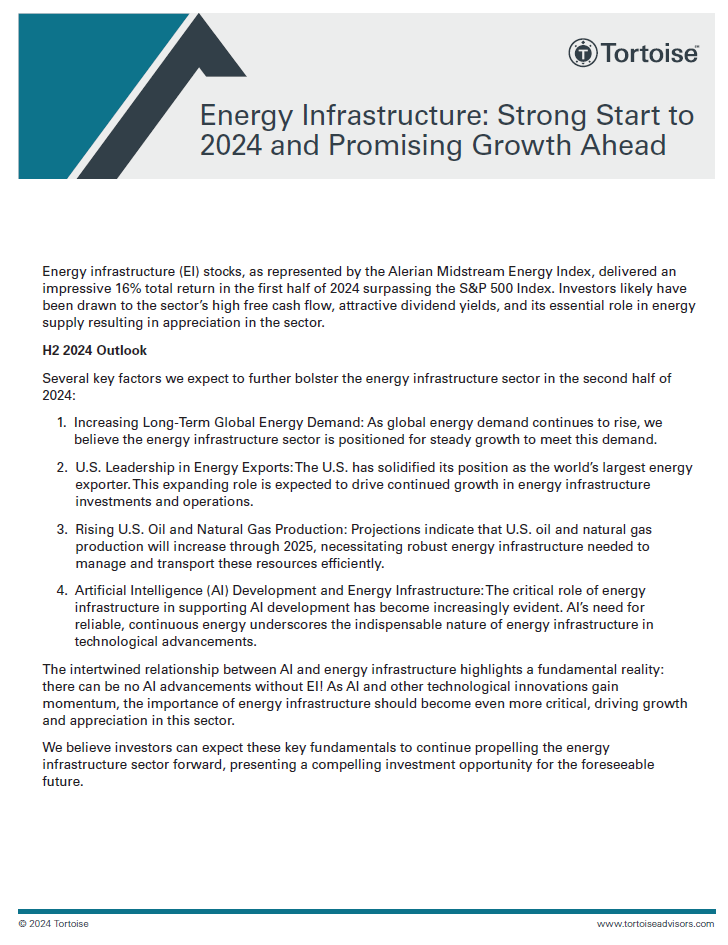July 26, 2024
Dear client,
The midstream energy sector continued to perform well in the second quarter of 2024. Growing free cash flow returned to shareholders in the form of bigger dividends and share buybacks, along with higher energy demand became even more evident. Further, forecasted artificial intelligence (AI) led electricity demand growth improved expectations for more natural gas supply. Finally, capital allocation focused on core assets is the predominant midstream management playbook that saw further execution in the quarter.
Midstream sector market update
In 2Q 2024, the Alerian Midstream Energy Total Return Index (AMNA) returned 5.4% and the Alerian MLP Index (AMZ) returned 3.4%. Supporting the sector were good earnings reports relative to consensus, continued management discipline toward capital allocation and mergers and acquisitions (M&A), and benign policy implications from Washington. We think midstream’s growing free cash flow, low leverage, and attractive valuation provide a compelling investment backdrop.
Earnings for midstream companies over the past six months came in at the high end of expectations following strong volumes, the robust 13% inflation tariff escalator, and isolated marketing opportunities from wide price differentials, particularly between west Texas and the Gulf Coast. On capital allocation, healthy balance sheets were maintained with dividend growth and share buybacks remaining a management focus. Leverage targets are now generally between 3.0x to 4.0x earnings before interest, taxes, depreciation and amortization (EBITDA) with leverage being a full “turn” lower versus levels prior to 2020. Buybacks eclipsed $1.5 billion in the quarter and are on pace to exceed our annual buyback expectation of $4 billion. Most notable to capital returns was Cheniere Energy’s outsized share repurchase at over $1 billion and Western Midstream’s 52% distribution boost. We expect free cash flow to increasingly be targeted at dividend growth and opportunistic share repurchases.
Midstream companies also looked to further boost their asset bases through bolt-on acquisitions from motivated private equity sellers, with three separate deals for Permian basin gathering and processing assets topping $4.5 billion in transaction value. Specifically, Energy Transfer agreed to acquire WTG Midstream, Kinetik bought Durango Midstream, and PSX tapped Pinnacle Midstream. Along with being accretive, the rationale for the Permian focus and synergy is the ability for the acquirors to more fully utilize existing infrastructure to transport increased volumes of natural gas and natural gas liquids to the demand and export center along the Gulf Coast. It was not all buying though. Companies also divested non-core assets, with Kinetik selling its interest in Gulf Coast Express and PSX dealing its position in Rockies Express. We believe complementary asset acquisitions combined with the pruning of non-core assets will continue through the remainder of the year and continue to serve investors well. Speaking of non-core assets, look for TC Energy to complete the announced spin-off of its liquids business, South Bow Corporation (SOBO), in the second half of this year.
The outsized buildout of datacenters to support AI is resulting in meaningful electricity growth in the U.S. after years of relatively stable demand. Further, data centers require a continuous and reliable power supply to ensure uninterrupted operations. We believe that renewables will play a role, yet neither solar nor wind are completely reliable. For that reason, we think natural gas is the best reliable supply source to meet this need because natural gas is relatively low cost, abundant domestically, and cleaner than coal. This idea continued to gain traction during the quarter with AI being mentioned countless times on energy conference calls. We estimate AI power demand growth could require an additional 7 to 16 billion cubic feet per day (bcf/d) of U.S. natural gas production to meet electricity demand from data centers. We expect this to benefit all forms of natural gas infrastructure over the next five years. And over the more immediate time period, we believe Independent Power Producers (IPPs) will profit from their ability to enter into power supply contracts with data centers and to supply marginal power to data centers when regulated electric utility companies are unable to meet demand. During these time periods, IPPs benefit from outsized power prices.
On the policy front, we expect November’s U.S. Presidential election to result in little impact to energy because under administrations of both parties U.S. energy production and exports grew, there was a relatively strict interpretation for clean energy incentives, and there was no thwarted energy M&A. During the quarter, the Supreme Court issued two rulings that make federal agency oversight of environmental and other policies more challenging. In the future, we expect that major changes in rules around energy production and consumption must arise from legislation instead of administrative fiat. Lastly, the Mountain Valley Pipeline (MVP) received all construction and operational permits and full authorization under the Fiscal Responsibility Act (FRA) last year. As a reminder, MVP is a 2 bcf/d pipeline transporting natural gas from the Marcellus shale into Virginia. After several years of delay, MVP entered operational service in June of 2024.
Strategy performance
The gross and net performance of the Tortoise Strategic Midstream Composite was 6.5% and 6.3% for the quarter, respectively. The Alerian Midstream Energy Total Return Index returned 5.4% for the same period. Your individual portfolio performance, taking fees into account, is available upon request.
Factors that drove the strategy’s performance during the quarter:
- All energy subsectors were positive except diversified infrastructure.
- Natural gas pipelines and gathering & processing and were the top performing segments.
- Diversified infrastructure and crude oil pipelines were the worst performing segments.
Concluding thoughts
Energy demand continues to grow globally, with artificial intelligence, a desire for higher standards of living, and more secure energy supplies driving North American energy. Energy infrastructure is necessary to connect supply with demand. We expect this environment will continue to reward energy infrastructure stocks over the long-term.
Sincerely,
The Tortoise power & energy infrastructure team




